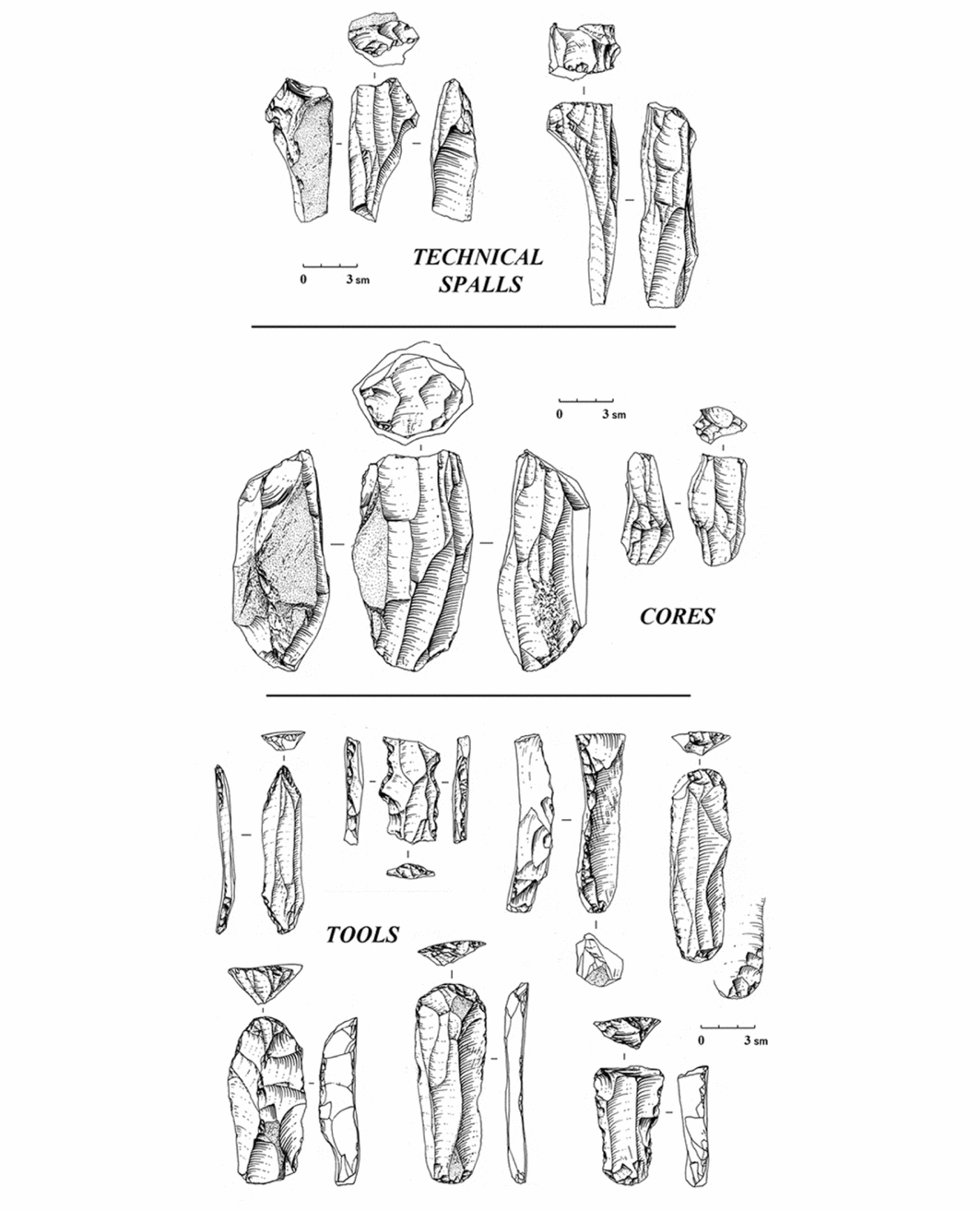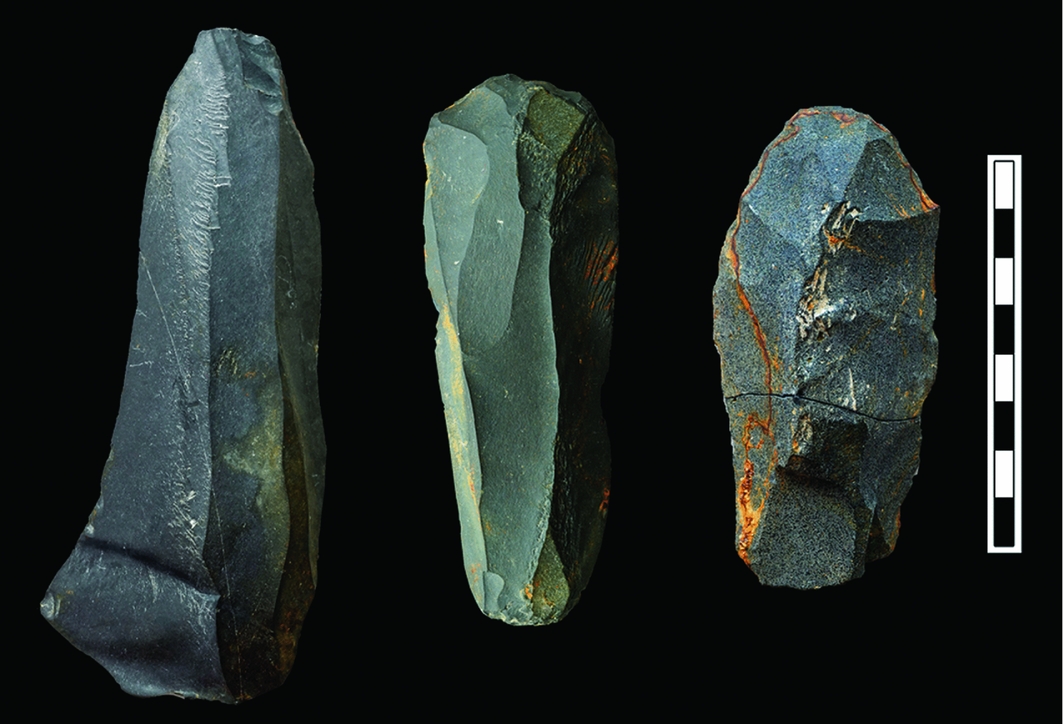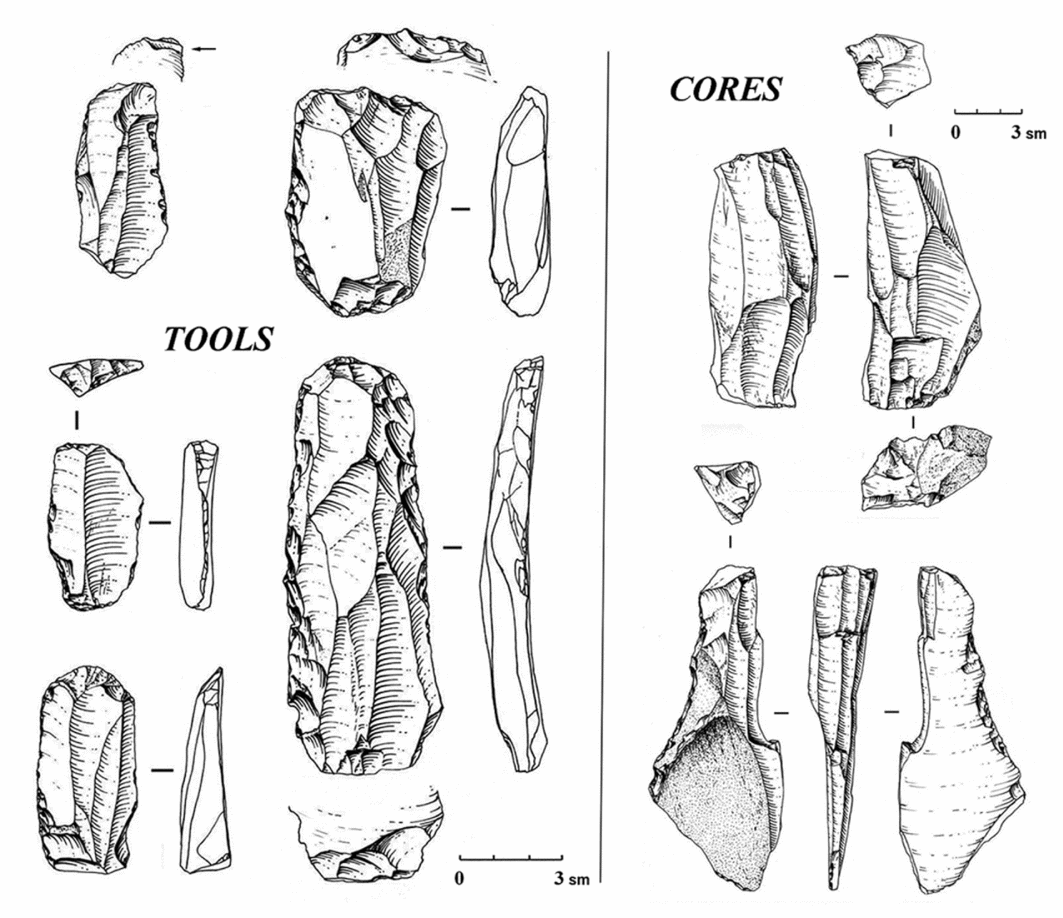In world archaeology, there has always been a problem regarding the Middle to Upper Palaeolithic transition. Late twentieth-century research has attempted to address this issue through the recognition of Initial Upper Palaeolithic (IUP) lithic industries. These assemblages were first characterised through evidence from the sites of Boker Tachtit and Ksar Akil (the Levant), and they are now identified in many regions of Eurasia, including Central Asia, the Near East, the Altai Mountains, Transbaikalia, Mongolia and northern China. A characteristic IUP assemblage has also been recently found in Kazakhstan (Ushbulak-1) (Shunkov et al. Reference Shunkov, Taymagambetov, Anoykin, Pavlenok, Kharevich, Kozlikin and Pavlenok2016). Large blades and elongated pointed flakes dominate these assemblages, and there is a prevalence of Upper Palaeolithic tool types in tool sets.
In 2016, the joint Russian-Kazakhstan expedition, organised by the Institute of Archaeology and Ethnography of the Siberian Branch of the Russian Academy of Sciences (SB RAS) and the National Museum of the Republic of Kazakhstan, conducted an archaeological reconnaissance in eastern Kazakhstan.
This resulted in the discovery of the stratified site of Ushbulak-1, located in the north-east of the Shilikty Valley (Figure 1). Abundant archaeological materials were found 100m along a stretch of the Vostochny stream, starting from its source (Figure 2), with approximately 1500 lithic objects found in great numbers lying directly on the streambed.

Figure 1. Location of the Ushbulak-1 site.

Figure 2. Plan of the 2016 excavation test pits at Ushbulak-1.
The main excavations were carried out on the left bank (the higher and steeper bank) of the stream (test pits 1 and 3) (Figure 3). Seven stratigraphic layers were identified in pit 1, six of which contained archaeological evidence. According to their composition and features, their stratigraphic positioning and associated faunal remains, three major cultural and chronological assemblages have been tentatively identified. These include the Holocene assemblage (layer 1), the Upper Palaeolithic assemblage (layers 2–4) and the IUP assemblage (layers 6–7).

Figure 3. Ushbulak-1, as seen from the north.
The IUP materials recovered from the lowest layers, 6 and 7 (pits 1 and 3; 598 objects), contain cores for producing blades, with the opposed platforms displaced relative to each other, numerous core-preparation flakes, end scrapers on large blades (including those with ventral base thinning), truncated blades and a tanged point (Figures 4–5). Virtually all typologically discernible cores were intended for blade production. Elongated blanks account for over 70 per cent of the flakes. With rare exceptions, the striking platforms are smooth. Large numbers of blanks demonstrate the use of various methods for overhang reduction, including the pecking method. Core-preparation flakes show good correlation with the set of cores. The majority of core-preparation flakes (crested and semi-crested, plunging and marginal laminar spalls) also correspond to laminar volumetric and semi-volumetric reduction. Generally, in terms of its morphology and other features, this assemblage of objects shows close similarity to the surface (streambed) assemblage collected at the site, which also reveals forms typical of the IUP (including burin-cores). That almost all artefacts collected from the surface collection originated from layer 6 is confirmed not only by their technical and typological features (Figure 6), but also by the geomorphological situation at the site.

Figure 4. Lithic artefacts from layer 6.

Figure 5. Lithic artefacts from layer 7.

Figure 6. Exposed artefacts from Ushbulak-1.
The presence of several specific object types from within the lower assemblage (e.g. burin-cores, end scrapers with ventral base thinning of the blank, truncated blades, a tanged point) makes it possible to attribute the site to the initial stages of the Upper Palaeolithic (45–35 kyr BP). Another indication is the predominance of blades among the flakes, including large blades of up to 0.2m in length, and the use of specific methods for overhang reduction (pecking).
The finds from layers 2–4 appear to correspond to a late stage of the Upper Palaeolithic (25–20 kyr BP). They are separated from the lower assemblage by a significant time gap, as indicated by an almost 1.5m-thick layer of archaeologically sterile deposits (layer 5) and by fundamentally different forms of lithic industry. The proportion of blades in layers 2–4 is much smaller compared to the lower cultural levels, whereas the percentage of flakes is much higher; the size of the spalls on the flakes is smaller; the flakes also show the use of methods for overhang reduction less frequently. The lack of distinctive tool forms in this assemblage makes it currently impossible to correlate it accurately with any specific period of the Upper Palaeolithic.
The assemblage from layer 1 included few artefacts. It can be attributed a Holocene date based on its stratigraphic position, pottery fragments, lithic artefacts showing no distinctive features and modern faunal remains.
The evidence shows that Ushbulak-1 is a stratified site with the earliest layers dating to the IUP (45–35 kyr BP). The composition of the lithic assemblage here suggests that the materials from layers 6 and 7 can be associated with a lithic workshop, which appears to have emerged on raw material outcrops located in the shore area of an ancient freshwater lake. Furthermore, at least two habitation horizons can be clearly seen in the lower part of layer 6, each of them corresponding to a single, short-term occupation event at the site.
Site stratigraphy and the deposition of artefacts suggest that further, larger-scale study of the site will make it possible to trace changes in its lithic industries from the Terminal Middle Palaeolithic through the IUP. Additional research would also establish the chronology for the regional IUP stone tool industries, as well as characteristics for the emergence of the local IUP assemblages.
In terms of tool types, the Ushbulak lithic industry shows similarity to the stratified assemblages attributed to the IUP found in southern Siberia (e.g. the Kara-Bom site) and northern Mongolia (e.g. the Tolbor-4 site). As the site of Ushbulak occupies an intermediate geographic position (approximately between southern Siberia and northern Mongolia), it is possible to integrate these industries into a single macroregion with a common lithic industry, and to track possible methods of distribution of the IUP blade industries from the Altai Mountains across eastern Kazakhstan, Dzungaria and Mongolian Altai, to Central Mongolia and Ordos.
Acknowledgements
Our research was supported by a grant (14-50-00036) from the Russian Science Foundation.








